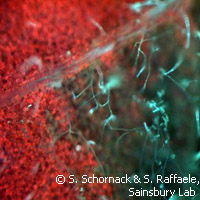Researchers unearth plant gene pathogens
An EU-funded team of researchers, led by the Sainsbury Laboratory, Norwich Research Park in the UK, have discovered the culprit responsible for late blight in potatoes and tomatoes, and downy mildew in cruciferous vegetables and other crops. Presented in the journal Science, the study was funded in part by the AVRBLB2-CPT ('Manipulation of host target by the AvrBlb2 effector of the late blight pathogen Phytophthora infestans') project, which received a Marie Curie Intra-European Fellowships grant worth EUR 171,740, under the EU's Seventh Framework Programme (FP7). The team put the spotlight on the parasitic water fungus and water molds that cause diseases in plants and crops. 'We have been studying the late blight pathogen for a while,' explains Professor Sophien Kamoun, head of the Sainsbury Laboratory at the Norwich Research Park. 'In separate research we are trialling plant genes that mediate blight resistance, while in this latest study we have learnt more about how the pathogen itself evolved and which genes we should focus on to tackle it.' In their research, the scientists compared the genome of the potato blight pathogen to the genomes of four sister species that infect various plants including the ornamental four oclock and morning glory. They say these closely related pathogens are from Mexico, the originating hub of the late blight pathogen. A number of sections of the genome evolve slowly and are very similar between the sister species, the experts found. Other sections enable the pathogen to jump hosts and adapt to and infect new plant species, according to them. 'Our aim is to develop resistance to genes from the stable, slowly-evolving region of the pathogen's genome,' Professor Kamoun says. 'This should be more disruptive to the pathogen's ability to evolve new races.' The team says the blight pathogen and the parasite responsible for generating downy mildew is a kind of water mold or oomycete, which are fungal-like organisms that evolved from marine algae. Downy mildew triggers fuzzy white mould and yellow patches on the leaves of various crops like maize, lettuce and grapes. Powdery mildew is a fungal disease of barley that causes the greatest damage in cool, wet climates. 'A major focus of our research is sustainable agriculture,' explains Professor Dale Sanders, the Director of the John Innes Centre in the UK. 'We need to help breeders and farmers generate good quality food and other agricultural products in an environmentally sustainable way. One way of doing so will be to develop crops that are resistant to pathogens and pests. Such crops will reduce the need to spray pesticides and fungicides and they will give better yields, as less will be lost to disease.' The genomes of the parasites were sequenced in two research studies, revealing that the parasites have discarded a number of genes. According to the scientists, the genome sequences show large numbers of effector proteins, the molecules that invade plant cells to stifle a plant's defence mechanism. Researchers from Germany and the US also contributed to this study.For more information, please visit: Sainsbury Laboratory:http://www.tsl.ac.uk/Science:http://www.sciencemag.org/
Countries
Germany, United Kingdom, United States



